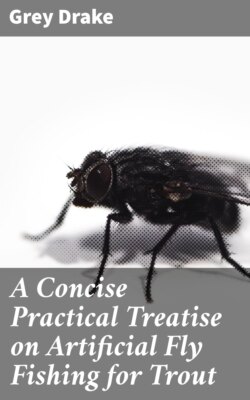Читать книгу A Concise Practical Treatise on Artificial Fly Fishing for Trout - Grey Drake - Страница 3
На сайте Литреса книга снята с продажи.
ОглавлениеA PRACTICAL TREATISE,
ETC.
Table of Contents
CHAPTER I.
Table of Contents
THE TACKLE.
I give no directions for making rods, lines, or flies. I recommend the purchase of these at the best fishing-tackle shops. As to the supposed advantage to the artificial fly-fisher of being able to make artificial flies by the river-side, in imitation of the fly actually on the water, I am confidently of opinion, the acquisition of that art is wholly unnecessary and useless, as I shall more fully explain hereafter.
THE ROD.
The rod can scarcely be too light and pliable. Its pliability assists greatly, not only in throwing the fly, but in hooking and retaining the fish. The butt end should have a hollow sufficient to hold an extra top-piece, secured by a brass screw-nut, which, when the rod is used, should be taken out, and a spike screwed into its place. The spike is very useful for sticking the rod upright in the ground, as occasion may require. Some prefer a two-handed rod for large rivers. I think it is unnecessarily fatiguing to use a two-handed rod, inasmuch as a skilful artist can throw a fly with a single-handed rod as far as is necessary, and I never use any other. The single-handed rod should be about thirteen or fourteen feet long. To prevent the danger of breaking the rod, by the joints separating in throwing the fly, the joints should be whipped with strong silk, as shown in this figure. Fly rods are sometimes made to attach their joints by screws at the butt ends. Whipping rods so made is of course unnecessary, but I do not approve of screw-jointed rods, as they cannot be made sufficiently light and pliable.
THE REEL.
I prefer the spring cog-check wheel, which, when the line is lengthened or shortened, makes a noise like that caused by winding up a clock. By this reel the line may be lengthened or shortened with sufficient rapidity, and with precisely, and no more than the proper resistance, the checks preventing the line running out too fast. This reel is, I think, far preferable to the multiplying reel, which is very liable to get out of order.
THE LINE.
I prefer a horsehair line. In length it should be proportioned to the size of the river you fish. For large rivers seventy or eighty yards are not too much; for narrow rivers thirty or forty yards are sufficient. It should gradually taper towards the end to which the gut or tail line is attached, so that from four to five yards should be little thicker than the gut itself. The gut, or tail line, should be at least three yards long; thick and strong for rainy and windy weather and discoloured water. It cannot be too fine for bright weather and clear water, with little wind.
